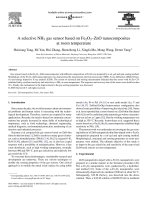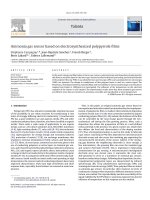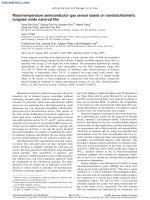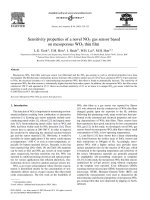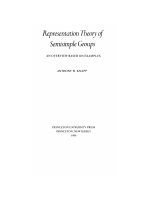- Trang chủ >>
- Khoa Học Tự Nhiên >>
- Vật lý
PH DEPENDENCE OF THE OPTICAL BIO SENSOR BASED ON DNA SEMICONDUCTOR GRAPHENE NANORIBBONS
Bạn đang xem bản rút gọn của tài liệu. Xem và tải ngay bản đầy đủ của tài liệu tại đây (468.37 KB, 6 trang )
Proc. Natl. Conf. Theor. Phys. 37 (2012), pp. 80-85
PH-DEPENDENCE OF THE OPTICAL BIO-SENSOR
BASED ON DNA - SEMICONDUCTOR GRAPHENE
NANORIBBONS
TRUONG THI CHINH, DINH VAN THIEN
University of Sciences - Vietnam National University
Hanoi University of Mining and Geology
NGUYEN AI VIET, TRAN THI THANH VAN
Institute of Physics, 10 Daotan, Badinh, Hanoi, Vietnam
Abstract. The pH dependence of the optical biosensor from DNA and semiconductor graphene
nanoribbonds (SGR) is investigated. Heller et al (Science 311, 508 (2006)) [1] have demonstrated
the first model of this kind of nano biosensors by wrapping a piece of double-stranded DNA around
the surface of single-walled carbon nanotubes CN. This new type of optical biosensor in the first
time can be placed inside living cells and detect trace amounts of harmful contaminants using near
infrared light. In our design model, instead of CN with cylinder shape we take semiconductor
graphene nanoribbonds (SGR) with flat geometry. Using the simple exciton theory in nanostructures, the periodic boundary conditions neglecting the edge effect, and the phenomena of B-Z
structural phase transition of DNA [2], we investigate working principle and pH dependence of
this new class of optical biosensor DNA-SGR responded to the presence of target ions. We have
shown the range of parameters for workable conditions of this biosensor. It is indicated that the
solution should have pH from 6 to 9, which is applicable for the living environments.
I. INTRODUCTION
Graphene has rapidly received significant attention since its discovery in 2004 by
Novoselov, Geim and co-workers [3]. It has been found that graphene has many unique
electrical, mechanical and physical properties, such as massless Dirac quasiparticles [4],
high carrier mobilities and capacities [3-4]. It is extremely important in many applications,
such as genomics, clinical diagnosis and pharmaceutics because of the ability to precisely
detect chemical and biological species .The symmetric band structure of graphene makes
it directly amenable to chemical and physical modification. In addition, the high carrier
mobility of graphene makes the modification detectable by simply monitoring its conductivity change. Since the discovery of graphene, there is great potential for building
graphene-based high-sensitivity, label-free, miniaturized electrostatic or electrochemical
sensors. One of the key challenges in current research and development of graphene-based
sensors is material handling and device fabrication . In 2006, Daniel A. Heller et al. [1]
demonstrated that carbon nanotubes (CNNTs) wrapped with DNA can be placed inside
living cells and detect trace amounts of harmful contaminants using near infrared light.
This discovery could lead to new types of optical sensors and biomarkers at the sub cellular level. The working principle of this optical biosensor from DNA and CNNTs can be
explained by a simple theoretical model which was introduced in [5]. Based on this model,
pH-DEPENDENCE OF THE OPTICAL BIO-SENSOR
81
a new design model of this sensor was introduced in [6], in which the CNNTs is replaced
by a semiconductor graphene ribbon (SGR). Using a simple theory of exciton in SGRs
[7], the transition of DNA secondary structure from the native, right-handed B form to
the alternate, left-handed Z form is investigated. This structural phase transition of DNA
is the working principle of this optical biosensor at the sub cellular level from DNA and
semiconductor graphene ribbons. It is proved that the AGNR-DNA based biosensors are
more sensitive than CNT-DNA based biosensors in [2]. pH is a measure of the acidity
or alkalinity of a certain solution and this optical bio-sensor based from DNA and SGR
is effected by pH of solution in some way, and investigating its properties vs pH is an
indispensable job as for biosensor from DNA and CNNTs. In this paper, we have shown
the working principle of this optical biosensor vs pH of solution. In particular, the pHdependence of DNA and the pH-dependence of solution around SGR are shown by using
data analysis method. We have shown the range of parameters for workable conditions
of this biosensor was indicated that the solution should have pH from 6 to 9, which is
applicable for the living environments.
II. MODEL
II.1. Theoretical model
In this paper, we investigated transition of DNA secondary structure from the native,
right-handed B form to the alternate, left-handed Z form by using a simple theory of
exciton in SGRs[8-10] . This structural phase transition of DNA is the working principle
of this optical biosensor at the sub cellular level from DNA and semiconductor graphene
ribbons. The theoretical model of biosensor based on DNA v SGR has been presented in
[6].
Here, we used a GNR that has w in width and an atomic layer in thickness. The
DNA strand is considered as a ribbon wrapping the GNR. The pitch along the axis of
helical DNA is b, and the width of DNA strand is a. Following previous work [6] the
system is depicted in Fig.1.
Fig. 1. The scheme of GNR-DNA based biosensor model
82
T.T.CHINH, D.V. THIEN, N.A. VIET, T.T.T.VAN
In this model, the effective dielectric constant of DNA and surrounding medium is
given:
ε = f.εDN A + (1 − f ).εW
(1)
Here εDN A and εW are the dielectric constants of DNA and solution, respectively,
and f is the ratio of DNA-covered surface area per total surface area of the GNR:
al
(2)
2bW
Where l is the straight length in a period of DNA. l is approximately calculated by
the following expression:
f=
b2
+ W2
4
And minimizing the potential energy in order to find the equilibrium system:
l=2
f=
a
2W
4π 2 .r02 + b20
4π 2 r02 + b20 − 4π.r0 W
(3)
(4)
Where r0 is the equilibrium radius, and b0 is the equilibrium pitch. In the case
of equilibrium system, here r0 , b0 , and a is 1nm, 3.32nm, and 0.51 nm, respectively, for
B-DNA; and r0 = 9 nm, b0 = 4.56 nm, and a = 1.18 nm for Z-DNA.
By using the separation of variables and solution of the Wannier model have been
applied to the 2D semiconductor systems and AGNR systems, the exciton energy levels
are given by:
2K 2
1
µ.e4
+
(5)
2 2 ε2 (n + 1/2)2 2(me + mh )
where Eexc is the exciton energy, Eg is the band gap, e is the relative dielectric
constant, n is an integer, and K is the wave vector. The second term is the binding
exciton energy, denoted by EB .
The binding exciton energy shifts at n = 0 when DNA change the form from Z-DNA
to B-DNA
Eexc = Eg −
2µ.e4 1
1
( 2 + 2)
(6)
2
eZ
eB
Here eB and eZ are the effective dielectric constant when DNA is in the form of B
and Z, respectively.
∆(EBZ ) =
II.2. Experimental parameters
When the pH of solution varies, the dielectric constants of DNA and solution around
the SGR change, it brings about the variation of effective dielectric constant. Therefore, the optical signals of our sensor change. So, it is important to investigate the
pH-dependence of dielectric constants of component parts, DNA and CNNTs. The pHdependence of the dielectric parameters of DNA was investigated in [11] by experiences.
pH-DEPENDENCE OF THE OPTICAL BIO-SENSOR
83
In this paper, we assumed that the dependence on the pH of the biosensor SGR-DNA and
biosensor CNNTs-DNA is the same. According to fitting results in [11], we have:
∆εDN A (pH) = εs − ε∞ = 0, 44.pH 3 − 0, 89.pH 2 + 5, 93.pH − 6, 24
(7)
The dielectric increment ∆ε which is a measure of the magnitude of the dielectric
dispersion is given by: ∆ε = εs − ε∞ where εs and ε∞ are the low-frequency and highfrequency relative permittivities describing the relaxation process, respectively. In our
problem, we just paid attention in the dielectric constant at low-frequency. Because ε∞ is
quite invariable and its value is around waters one. In our computation, we seted it equal
to 80. According to [2], we have:
Kp
Kp
A(pH) − Ap
=
= −npH
+
n
Ad − Ap
[H ] + Kp
10
+ Kp
(8)
Or
Kp
+ Kp
(9)
+ Kp
Here, Kp is the reaction equilibrium constant, Ap and Ad as the absorption intensities of the protonated and deprotoanted states. Approximately, the values of lnKp range
from -36.39 to -33.97 [8] and the average number of protons reacting per protonated entity
was determined to be n = 3.
Otherwise, the absorbance of photons is given by the golden rule:
A(pH) = (Ad − Ap )
[H + ]n
e2
| e.pcv |2 δ(Ev + ω − Ee )
(10)
εs (pH)
In case, the SGR is in the normal solution at a neutral pH, the dielectric constant
is ε0 (equal to the dielectric constant of water of 80), the neutral absorbance of photons
A0 would be:
A(pH) = Const
e2
| e.pcv |2 δ(Ev + ω − Ee )
(11)
ε0
Dividing (10) to (11), and substituting (9) into the obtained equation then gives:
εs
A0
=
(12)
Kp
ε0
(Ad − Ap ). + n
+ Ap
[H ] + Kp
A0 =
III. RESULTS
Dielectric constants of DNA and solution around SGR are varied when thesolution
pH changes. So, the pH dependence of effective dielectric constant will be expressed as:
ε(pH) = f.εDN A (pH) + (1 − f ).εs (pH)
(13)
The effective dielectric constant of solution around sensor versus pH curves is illustrated in Fig. 2
The exciton binding energy of SWNT in the solution would be written as follow:
84
T.T.CHINH, D.V. THIEN, N.A. VIET, T.T.T.VAN
Fig. 2. pH-Dependence of the dielectric constant
Ebind (pH) = A.Rα−2 µα−1 ε−α (pH)
(14)
And the neutral exciton binding energy is:
Ebind (pH) = A.Rα−2 µα−1 ε−α
0
(15)
Dividing (14) to (15), the exciton binding energy of SGR in the solution is written
as:
Eext (pH)
(0)
Eβ
=
Eg
(0)
Eβ
=
ε0
f.εDN A (pH) + (1 − f ).εs (pH)
α
The pH-dependence of the exciton binding energy is insulated in Fig.4
Fig. 3. The pH-dependence of the exciton binding energy
(16)
pH-DEPENDENCE OF THE OPTICAL BIO-SENSOR
85
IV. CONCLUSIONS
This new combining structure of DNA and SGR is really interesting. The biosensor
based on DNA and GNR open new prospects of CNNT applications on nanotechnology in
the future, due to their potential applications. By using a simple model for DNA, we have
investigated the environment-dependent properties of biosensor. We showed the expression
of effective dielectric constant of medium. The pH dependence of the optical biosensor
from DNA and semiconductor graphene nanoribbonds (SGR) is investigated and we can
see that, the workable solution for sensor should has pH from 6 to 9. Therefore, we can
choose the best parameters for the model. The sensors properties depend on temperature,
pKa, pressure, etc are still such interesting ways for studying more.
REFERENCES
[1] Daniel A. Heller, Esther S. Jeng, Tsun - Kwan Yeung, Brittany M. Martinez, Anthonie E. Moll,
Joseph B. Gastala, Michael S. Strano, Science 311 (2006) 508.
[2] ,D. P. Hung, D. L. Hien, D. T. Nga, N. V. Thanh, and N. A. Viet, Comm. Phys. 18 (2008) 151-156.
[3] Novoselov, K.S., A.K. Geim, S.V. Morozov, D. Jiang, Y. Zhang, S.V. Dubonos, I.V. Grigorieva, and
A.A. Firsov, Electric field effect in atomically thin carbon films. Science, 2004. 306(5696): p. 666-669.
[4] Novoselov, K.S., A.K. Geim, S.V. Morozov, D. Jiang, M.I. Katsnelson, I.V. Grigorieva, S.V.
Dubonos, and A.A. Firsov, Two-dimensional gas of massless dirac fermions in graphene. Nature,
2005. 438(7065): p. 197-200
[5] Vu Thuy Huong, Quach Kha Quang, Tran Thanh Thuy, Phan Duc Anh, Ngo Van Thanh, And Nguyen
Ai Viet, Comm. Phys. 4 (2009) 309-317.
[6] Anh D.Phan and N.A.Viet, J. Appl. Phys. 111 (2012) 114703/1-1147035/5.
[7] Stephen Bone, Caroline A.S., Biochimica et Biophysica Acta 1260 (1995) 85-93.
[8] Y.L. Jiaa , X. Geng, H. Sun, and Y. Luo, Eur. Phys. J. B 83(2011), 451455.
[9] L. Mohammadzadeh , A. Asgari , S.Shojaei1 , and E. Ahmadi, Eur. Phys. J. B 84(2011), 249253.
[10] Xi Zhu and Haibin Su, J. Phys. Chem. C, 114(2010), 1725717262.
Received 30-09-2012.



